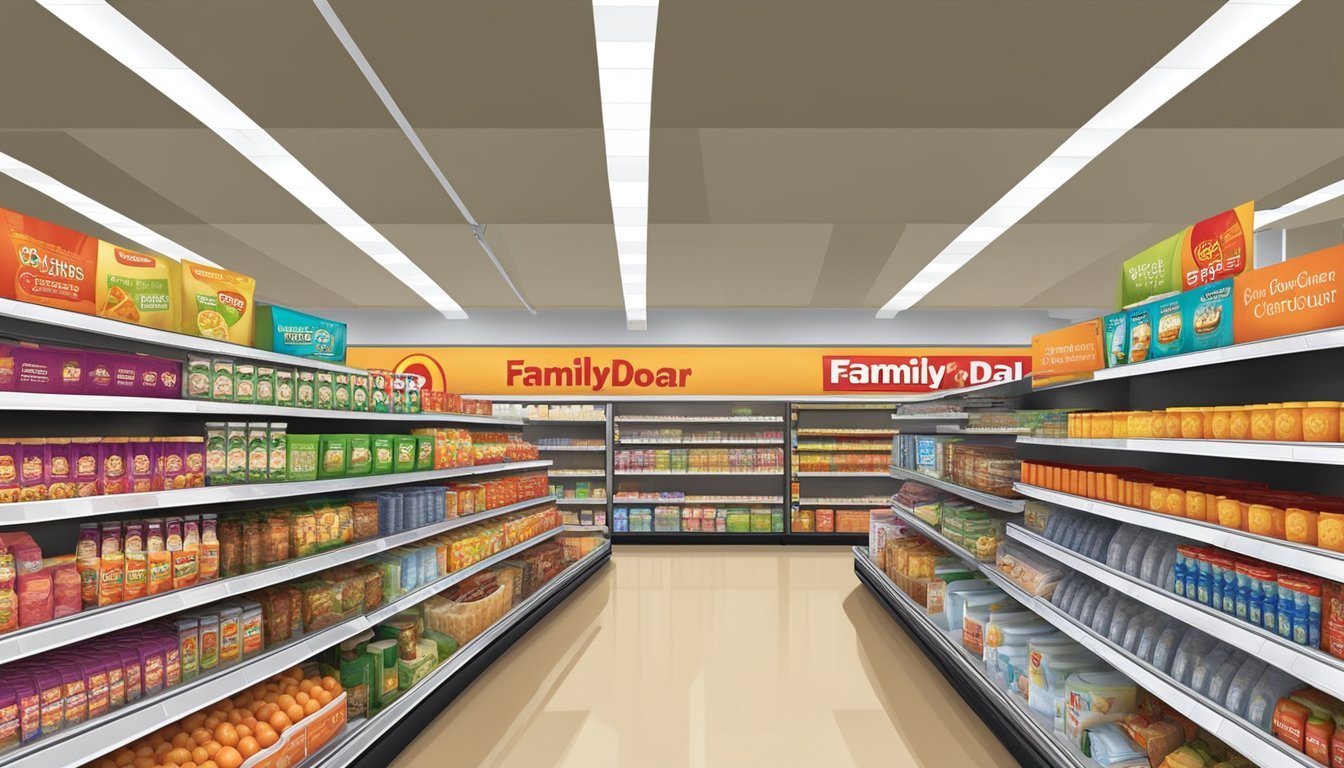Family Dollar vs Grocery Outlet
Comparing Budget-Friendly Options
As grocery prices continue to climb, savvy shoppers are turning to discount stores like Family Dollar and Grocery Outlet for affordable options. These retailers offer budget-friendly alternatives to traditional supermarkets, but they differ in their approach and product selection.
Grocery Outlet generally provides better value and a wider range of groceries compared to Family Dollar. While Family Dollar focuses on household essentials and non-perishable items, Grocery Outlet offers a broader selection of fresh produce, meats, and name-brand products at discounted prices. This makes Grocery Outlet a more comprehensive option for customers seeking to do their full grocery shopping at a discount retailer.
Both stores cater to budget-conscious shoppers, but their shopping experiences vary. Family Dollar provides a consistent inventory across its locations, making it reliable for specific items. Grocery Outlet, on the other hand, operates with an ever-changing inventory of surplus and closeout products, creating a treasure hunt atmosphere that appeals to bargain hunters.
Background and Overview
Family Dollar and Grocery Outlet are two distinct retail chains that have carved out unique niches in the discount grocery and general merchandise market. Both offer value-driven shopping experiences but differ in their origins, operational approaches, and product offerings.
History of Family Dollar
Family Dollar was founded in 1959 by Leon Levine in Charlotte, North Carolina. The company started as a single store offering a variety of household goods at discounted prices. By the 1970s, Family Dollar had expanded to over 100 stores across the southeastern United States.
Family Dollar's growth continued steadily over the decades. In 2015, the company was acquired by Dollar Tree, creating one of the largest discount retailers in North America. Despite the acquisition, Family Dollar maintains its distinct brand identity and store format.
The chain now operates thousands of stores across 46 states, providing customers with a mix of groceries, household items, and personal care products at competitive prices.
History of Grocery Outlet
Grocery Outlet's roots trace back to 1946 when Jim Read opened Cannery Sales in San Francisco. The store initially sold military surplus items at low prices. Over time, it evolved into a deep-discount grocery store concept.
The business underwent several name changes before becoming Grocery Outlet in 1987. In 2009, it adopted the full name Grocery Outlet Bargain Market to better reflect its focus on discounted merchandise.
Grocery Outlet has expanded beyond its California origins and now operates stores in multiple states, including Oregon, Washington, Idaho, Nevada, and Pennsylvania. The company specializes in offering name-brand and private-label products at significant discounts.
Business Models
Family Dollar employs a traditional discount store model. It maintains consistent low prices across a wide range of everyday items. The stores are typically smaller than traditional supermarkets and focus on essential household goods and groceries.
Key features of Family Dollar's model:
Fixed low pricing on most items
Mix of name-brand and private-label products
Emphasis on convenience and quick shopping trips
Grocery Outlet operates on a unique "opportunistic sourcing" model. The company purchases surplus inventory, overstocks, and closeout products from manufacturers at deep discounts. This allows them to offer significant savings to customers.
Grocery Outlet's model highlights:
Constantly changing inventory based on available deals
Deeper discounts on name-brand products
Focus on grocery items with some general merchandise
Both chains differ from traditional grocery stores and warehouse clubs in their size, product selection, and pricing strategies. They aim to provide value-conscious shoppers with affordable options for everyday needs.
Store Locations and Accessibility
Family Dollar and Grocery Outlet have distinct approaches to their store locations and distribution. This impacts customer accessibility and shopping convenience across different regions of the United States.
Family Dollar's National Presence
Family Dollar boasts a widespread national presence with thousands of stores across the country. The chain operates in 46 states, providing easy access for customers in urban, suburban, and rural areas. Many Family Dollar stores are strategically located in small towns and neighborhoods, catering to local communities.
Family Dollar's extensive network allows for greater convenience, as customers can often find a store within a short distance from their homes. This accessibility is particularly beneficial for those with limited transportation options.
Grocery Outlet's Regional Focus
Grocery Outlet maintains a more concentrated presence in specific regions. The chain primarily operates in the western United States, with a strong foothold in California, Oregon, and Washington. Grocery Outlet has been gradually expanding its reach to other states, including Pennsylvania, New Jersey, and Idaho.
While not as widespread as Family Dollar, Grocery Outlet's regional focus allows the company to tailor its offerings to local preferences and tastes. This strategy can result in a more personalized shopping experience for customers within its service areas.
Comparing Store Proximity
When it comes to store proximity, Family Dollar generally offers greater accessibility due to its national presence. Customers in most parts of the country are likely to find a Family Dollar nearby.
Grocery Outlet's store locations are more limited, which may require some customers to travel farther for their shopping needs. However, in areas where Grocery Outlet operates, the stores are often strategically placed to serve local communities effectively.
For customers living in regions where both chains are present, the choice between Family Dollar and Grocery Outlet may depend on individual store locations and personal preferences.
Product Range and Variety
Family Dollar and Grocery Outlet offer distinct product ranges to cater to different customer needs. Both stores aim to provide affordable options, but their selections vary in key ways.
Brand Assortment
Family Dollar stocks a mix of name-brand and generic products across various categories. Customers can find familiar brands like Coca-Cola, Kraft, and Colgate alongside budget-friendly alternatives. The store focuses on everyday essentials, including snacks, beverages, and basic household items.
Grocery Outlet, on the other hand, specializes in offering name-brand products at discounted prices. Their inventory changes frequently, featuring overstock items and closeouts from major manufacturers. Shoppers might find premium brands like Kettle Chips, Ghirardelli, or Seventh Generation at significant markdowns.
Private Labels and Exclusives
Family Dollar has developed its own private label brands to offer even more affordable options. These include Family Gourmet for food items, Family Chef for kitchen essentials, and Kidgets for baby products. These store brands often provide comparable quality to national brands at lower prices.
Grocery Outlet doesn't have its own private label line. Instead, they focus on sourcing exclusive deals on existing brands. This approach allows them to offer a rotating selection of unique products that may not be available at other retailers.
Specialty Items
Family Dollar maintains a consistent inventory of basic groceries and household goods. Their specialty items are typically seasonal, such as holiday decorations or summer outdoor products. The store aims to be a one-stop shop for essential items rather than gourmet or niche products.
Grocery Outlet shines in its specialty offerings. The store often features organic produce, artisanal cheeses, and gourmet snacks at discounted prices. Wine enthusiasts appreciate their selection of high-quality wines at bargain prices. The ever-changing inventory means shoppers can discover new and exciting products on each visit.
Price Comparison and Savings
Family Dollar and Grocery Outlet offer competitive pricing strategies to attract budget-conscious shoppers. Both stores aim to provide savings through different approaches to pricing, promotions, and customer rewards.
Everyday Prices
Family Dollar maintains consistently low prices across its product range. The store focuses on offering affordable options for household essentials and groceries.
Grocery Outlet, on the other hand, operates on an opportunistic buying model. This allows them to sell brand-name products at significant discounts, often 40-70% below conventional retail prices.
The price difference between the two stores can vary depending on the specific items. For staple goods, Family Dollar may offer more stable pricing, while Grocery Outlet excels in providing deep discounts on rotating inventory.
Discounts and Deals
Family Dollar regularly features weekly sales and special promotions. These often include:
Buy-one-get-one deals
Dollar Deals sections
Clearance items
Grocery Outlet's entire business model revolves around discounts. They offer:
Constantly changing inventory of discounted products
Seasonal and holiday specials
Markdowns on short-dated items
Both stores use loss leaders to draw customers, but Grocery Outlet's unpredictable stock means shoppers may find more unexpected bargains.
Loyalty Programs
Family Dollar offers a digital coupon program called "Smart Coupons." Customers can:
Load digital coupons to their account
Receive personalized offers
Earn rewards on purchases
Grocery Outlet does not have a traditional loyalty program. Instead, they focus on:
Providing consistent low prices without the need for a membership
Offering occasional in-store coupons
Running local promotions through individual store operators
While Family Dollar's program provides ongoing savings for regular shoppers, Grocery Outlet's approach emphasizes immediate discounts without requiring customer sign-up or tracking.
Quality of Goods
Family Dollar and Grocery Outlet offer different levels of quality in their product selections. Both stores aim to provide affordable options, but their approaches to sourcing and stocking items vary.
Freshness of Produce and Meats
Family Dollar typically carries a limited selection of fresh produce and meats. Their focus is more on shelf-stable and frozen foods. The produce available may not always be the freshest due to lower turnover rates.
Grocery Outlet, in contrast, often has a wider variety of fresh produce and meats. They source overstock and closeout items from other retailers, which can result in fresher options at lower prices. However, the selection can be inconsistent from visit to visit.
Both stores may offer deals on produce nearing its sell-by date. Shoppers should check expiration dates carefully, especially on perishable items.
Quality of Non-Perishable Items
Family Dollar stocks many well-known national brands alongside their own private label products. These items are generally of consistent quality, though they may be in smaller package sizes compared to traditional grocery stores.
Grocery Outlet specializes in offering brand-name products at discounted prices. They acquire overstock, discontinued items, and packaging changes from manufacturers. This can result in high-quality items at significantly reduced prices.
Both stores carry a mix of name-brand and generic products. Grocery Outlet tends to have a more diverse selection of non-perishable goods due to their unique sourcing model.
Organic and Health Options
Family Dollar has limited organic and health-focused options. Their selection typically includes basic health and wellness products, but specialty items are rare.
Grocery Outlet often features a surprising array of organic and health-conscious products. They frequently stock organic produce, natural snacks, and specialty diet items at discounted prices. The availability of these products can vary greatly between visits.
Neither store specializes in organic or health foods, but Grocery Outlet generally offers more options in this category. Shoppers seeking specific health-focused items may find better variety at Grocery Outlet, though selection is not guaranteed.
Shopping Experience
Family Dollar and Grocery Outlet offer distinct shopping experiences tailored to their target customers. Both prioritize affordability but differ in store layout, customer service, and checkout processes.
Store Layout and Navigation
Family Dollar stores typically have a compact layout with narrow aisles. Products are arranged in categories, with household items, groceries, and seasonal goods spread throughout the store. Signage helps guide customers, but the cramped space can make navigation challenging during busy times.
Grocery Outlet features a more spacious layout resembling traditional supermarkets. Wide aisles and clear department markers make it easier for shoppers to find what they need. The store's ever-changing inventory of discounted items adds an element of treasure hunting to the experience.
Customer Service
Family Dollar generally maintains a lean staff to keep costs down. Employees focus on restocking shelves and operating registers. Assistance may be limited during peak hours, and shoppers often need to search for help when required.
Grocery Outlet employs more staff members on the sales floor. Employees are typically knowledgeable about product locations and current deals. Many stores are independently owned, fostering a community-oriented atmosphere with personalized service.
Checkout Efficiency
Family Dollar emphasizes quick transactions. Self-checkout kiosks are available in some locations, speeding up the process for customers with few items. During busy periods, lines can form quickly due to limited register space.
Grocery Outlet maintains a balance between efficiency and personalized service at checkout. Multiple registers are usually open during peak hours. Cashiers often engage in friendly conversation while scanning items, creating a more relaxed checkout experience.
Convenience and Additional Services
Family Dollar and Grocery Outlet offer distinct convenience features and services to enhance the shopping experience. Their approaches differ in terms of store accessibility, parking, and digital offerings.
Parking and In-Store Services
Family Dollar typically locates its stores in easily accessible areas with ample parking spaces. Many outlets provide basic in-store services like ATMs and money transfers. The stores' compact size allows for quick shopping trips.
Grocery Outlet often occupies larger retail spaces in shopping centers. This usually means more parking availability for customers. Some locations offer cart return areas in parking lots for added convenience.
Grocery Delivery and Online Shopping
Family Dollar has expanded into e-commerce, offering online shopping and delivery options in select areas. Customers can browse products on the company's website or mobile app and have items shipped to their homes.
Grocery Outlet has been slower to adopt online services. Most locations do not offer grocery delivery or pickup options. The company focuses on in-store experiences, encouraging customers to discover deals in person.
Neither chain provides extensive digital services compared to major supermarkets. Their strategies prioritize physical store operations over online expansions.
Customer Perceptions and Brand Reputation
Customer opinions and loyalty play crucial roles in the success of Family Dollar and Grocery Outlet. These factors shape how consumers view and interact with each brand.
Consumer Ratings and Feedback
Family Dollar receives mixed reviews from customers. Some appreciate its low prices and convenient locations. Others express concerns about store cleanliness and product quality. A ConsumerPedia podcast highlighted that Family Dollar stores in certain areas struggle with organization and stock issues.
Grocery Outlet garners more positive feedback overall. Customers praise its diverse product selection and significant discounts. Many shoppers enjoy the "treasure hunt" experience of finding unique deals. However, some note inconsistent inventory as a potential drawback.
Online ratings tend to favor Grocery Outlet, with higher average scores across review platforms. Customers frequently mention friendly staff and unexpected bargains as key positives.
Brand Loyalty
Family Dollar has a dedicated customer base, particularly in rural and urban areas with limited shopping options. Many families rely on its affordable household essentials and seasonal items. The store's predictable inventory helps build trust among regular shoppers.
Grocery Outlet cultivates a different type of loyalty. Its ever-changing inventory attracts bargain hunters and adventurous shoppers. The company's "WOW!" deals create excitement and encourage repeat visits. Surveyed area consumers often describe Grocery Outlet as a fun, budget-friendly alternative to traditional supermarkets.
Both brands face challenges in customer retention. Family Dollar works to improve store conditions and expand product lines. Grocery Outlet focuses on maintaining its reputation for exceptional values and unique finds.
Market Impact and Industry Standing
Family Dollar and Grocery Outlet have significantly influenced the grocery retail landscape, reshaping competition and consumer expectations. Their unique business models have made waves in an industry dominated by traditional supermarket chains.
Effect on Local Competition
Family Dollar's expansion into grocery items has intensified competition in many local markets. The chain's focus on low-priced essentials challenges both small independent stores and larger grocery chains. Family Dollar's presence often leads to price adjustments by competitors, benefiting price-conscious shoppers.
Grocery Outlet's opportunistic buying model allows it to offer name-brand products at steep discounts. This approach has disrupted local markets by attracting budget-minded consumers away from traditional grocery stores. The U.S. Bureau of Labor Statistics reports that grocery prices have risen consistently in recent years, making Grocery Outlet's discounts particularly appealing.
Contribution to the Grocery Industry
Family Dollar has expanded the concept of dollar stores by incorporating a wider range of grocery items. This shift has blurred the lines between discount stores and traditional grocery retailers, forcing the industry to reevaluate consumer shopping habits.
Grocery Outlet's success has highlighted the importance of flexible purchasing strategies in the grocery sector. Their model of buying excess inventory and discontinued items has created a new niche in the market. This approach has inspired other retailers to explore similar tactics to reduce waste and offer competitive prices.
Both companies have pushed larger grocery chains to innovate and adapt their strategies to maintain market share. This competition has led to improved efficiency and value for consumers across the industry.
Conclusion
Family Dollar and Grocery Outlet offer distinct shopping experiences for budget-conscious consumers. Each store has its strengths and weaknesses in terms of pricing, product selection, and overall value.
Choosing the Right Store for Your Needs
Family Dollar excels in convenience and everyday essentials. It's ideal for quick shopping trips and basic household items. The store's smaller footprint makes it accessible in urban areas.
Grocery Outlet shines with its rotating inventory of discounted brand-name products. It appeals to shoppers who enjoy the "treasure hunt" experience. The store offers significant savings on groceries, but selection can be unpredictable.
Location plays a crucial role in store choice. Family Dollar has a wider presence, especially in rural and urban areas. Grocery Outlet is expanding but remains less ubiquitous.
Quality varies between the two. Grocery Outlet often carries higher-end brands at discount prices. Family Dollar focuses more on budget-friendly private labels.
Future Outlook
Both chains are adapting to changing consumer habits. Family Dollar is expanding its grocery offerings to compete with traditional supermarkets. This move aims to attract more frequent shoppers.
Grocery Outlet is leveraging its unique business model to grow. The company plans to open more locations, bringing its bargain-hunting experience to new markets.
E-commerce integration is a key focus for both retailers. Family Dollar is partnering with Instacart for home delivery. Grocery Outlet is exploring online ordering options while maintaining its in-store bargain model.
Customer loyalty programs are becoming more important. These initiatives aim to increase repeat visits and compete with larger grocery chains.










